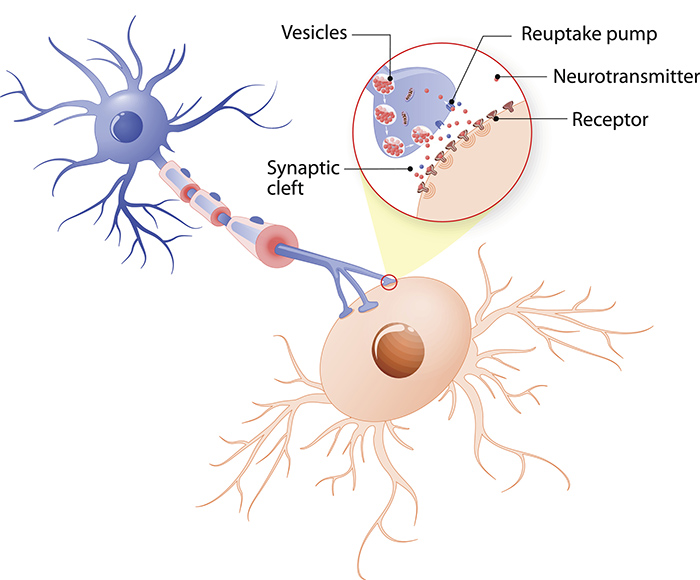What are neurotransmitters?

Image credit: iStockphoto
Neurotransmitters are often referred to as the body’s chemical messengers. They are the molecules used by the nervous system to transmit messages between neurons, or from neurons to muscles.
Communication between two neurons happens in the synaptic cleft (the small gap between the synapses of neurons). Here, electrical signals that have travelled along the axon are briefly converted into chemical ones through the release of neurotransmitters, causing a specific response in the receiving neuron.
A neurotransmitter influences a neuron in one of three ways: excitatory, inhibitory or modulatory.
An excitatory transmitter promotes the generation of an electrical signal called an action potential in the receiving neuron, while an inhibitory transmitter prevents it. Whether a neurotransmitter is excitatory or inhibitory depends on the receptor it binds to.
Neuromodulators are a bit different, as they are not restricted to the synaptic cleft between two neurons, and so can affect large numbers of neurons at once. Neuromodulators therefore regulate populations of neurons, while also operating over a slower time course than excitatory and inhibitory transmitters.
Most neurotransmitters are either small amine molecules, amino acids, or neuropeptides. There are about a dozen known small-molecule neurotransmitters and more than 100 different neuropeptides, and neuroscientists are still discovering more about these chemical messengers. These chemicals and their interactions are involved in countless functions of the nervous system as well as controlling bodily functions.
Key neurotransmitters
The first neurotransmitter to be discovered was a small molecule called acetylcholine. It plays a major role in the peripheral nervous system, where it is released by motor neurons and neurons of the autonomic nervous system. It also plays an important role in the central nervous system in maintaining cognitive function. Damage to the cholinergic neurons of the CNS is associated with Alzheimer disease.
Glutamate is the primary excitatory transmitter in the central nervous system. Conversely, a major inhibitory transmitter is its derivative γ-aminobutyric acid (GABA), while another inhibitory neurotransmitter is the amino acid called glycine, which is mainly found in the spinal cord.
Many neuromodulators, such as dopamine, are monoamines. There are several dopamine pathways in the brain, and this neurotransmitter is involved in many functions, including motor control, reward and reinforcement, and motivation.
Noradrenaline (or norepinephrine) is another monoamine, and is the primary neurotransmitter in the sympathetic nervous system where it works on the activity of various organs in the body to control blood pressure, heart rate, liver function and many other functions.
Neurons that use serotonin (another monoamine) project to various parts of the nervous system. As a result, serotonin is involved in functions such as sleep, memory, appetite, mood and others. It is also produced in the gastrointestinal tract in response to food.
Histamine, the last of the major monoamines, plays a role in metabolism, temperature control, regulating various hormones, and controlling the sleep-wake cycle, amongst other functions.
